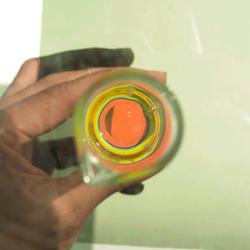Source Institutions
Source Institutions
Add to list Go to activity
Activity link broken? See if it's at the internet archive

In this activity, learners explore what happens when polarized white light passes through a sugar solution. Learners use a relatively simple setup to investigate light polarization and reveal beautiful colors. Learners will discover that the colors change as the depth of the sugar solution changes or as the polarizing filter rotates. Learners can also explore what happens when they place a colored filter under the tube holding the sugar solution and/or try a variety of transparent liquids and solutions (e.g. honey) to test whether some are better than others at changing the direction of polarization.
- 10 to 30 minutes
- 30 to 45 minutes
- $1 - $5 per student
- Ages 8 - 18
- Activity, Demonstration
- English
Quick Guide
Materials List (per student)
- A clear plastic or glass (100 ml) graduated cylinder. (Or make your own. See Assembly for instructions.)
- 2 pieces of polarizing material, such as the lenses from a pair of polarizing sunglasses
- Karo® syrup
- A light source. (Brightly illuminated sheet of white paper, overhead projector, or flashlight.)
- (Optional) Clear plastic cylinder 1 inch (2.5 cm in diameter (either solid or hollow) witih one closed end
- (Optional) Colored filters
- (Optional) Other liquids that can take the place of the Karo® syrup (optional)
Subjects
-
Life Sciences
-
Human Senses and Perception
- Vision
-
Human Senses and Perception
-
Physical Sciences
-
Chemistry
- Solutions
-
Vibration and Waves
- Wave Properties
- Wave Motion
-
Light and Optics
- Electromagnetic Spectrum
- Reflection and Refraction
-
Chemistry
-
The Nature of Science
-
The Scientific Process
- Conducting Investigations
-
The Scientific Process
Informal Categories
- Food and Cooking
Audience
To use this activity, learners need to:
- see
- see color
- touch
Learning styles supported:
- Involves hands-on or lab activities
Other
This resource is part of:
Access Rights:
- Free access
By:
Rights:
- All rights reserved, The Exploratorium,
Funding Sources:
- National Science Foundation
- California Department of Education
- NEC Foundation of America
